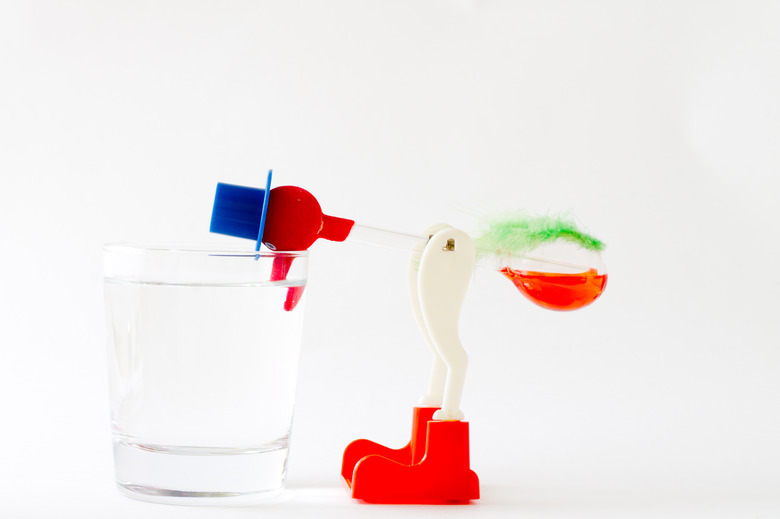How To Make A Perpetual Motion Water Drinking Toy Bird
A perpetual motion drinking bird is powered by the heat differential between its head and tail. In an upright position, the felt bill of the bird is wetted, cooling it by evaporation. The contraction of the gas in the head leads to pressure reduction, which leads to methyline chloride in the tail bulb being sucked up. After becoming top-heavy, the bird drops forward. Its head dunked in cold water, the methylene chloride from the tail (both gas and liquid) cools and withdraws back into the tail, the two bulbs now in equilibrium.
Dunking Bird
Step 1
Fill one of the two glass bulbs with methylene chloride.
Step 2
Insert a glass tube into the filled bulb, almost to the bottom, then seal the bulb opening around the tube.
Step 3
Seal the second bulb onto the top of the tube, except for a small opening for evacuation.
The tube should not extend into the top bulb, since the liquid should be able to evacuate from the top bulb easily.
Step 4
Evacuate the air and seal the top bulb entirely.
Step 5
Attach an external clamp to the middle of the tube, with small arms.
Set the arms in a stand. The stand should be designed so the bird is never fully erect, but leaning forward at least a little. This way, any top-heaviness turns into its dropping forward to be cooled in a cup of water.
Step 6
Cover the top bulb with felt hood, preferably with a felt tip for a bill.
When "dunking," the liquid level will drop enough in the tail bulb that warmer gas from the tail will escape to the head bulb to be cooled by the wet felt. The liquid will then drain into the tail bulb, and the bird will right itself again.
Things Needed
- Glass tube
- Two glass bulbs
- Methylene chloride
- Glassware experience
- Evacuation equipment
TL;DR (Too Long; Didn't Read)
Some trial and error may be required to see how much methylene chloride makes the dunking work the best for your size of bulbs and the distance you insert the tube.
Cite This Article
MLA
Dohrman, Paul. "How To Make A Perpetual Motion Water Drinking Toy Bird" sciencing.com, https://www.sciencing.com/make-water-drinking-toy-bird-5547456/. 22 November 2019.
APA
Dohrman, Paul. (2019, November 22). How To Make A Perpetual Motion Water Drinking Toy Bird. sciencing.com. Retrieved from https://www.sciencing.com/make-water-drinking-toy-bird-5547456/
Chicago
Dohrman, Paul. How To Make A Perpetual Motion Water Drinking Toy Bird last modified March 24, 2022. https://www.sciencing.com/make-water-drinking-toy-bird-5547456/
